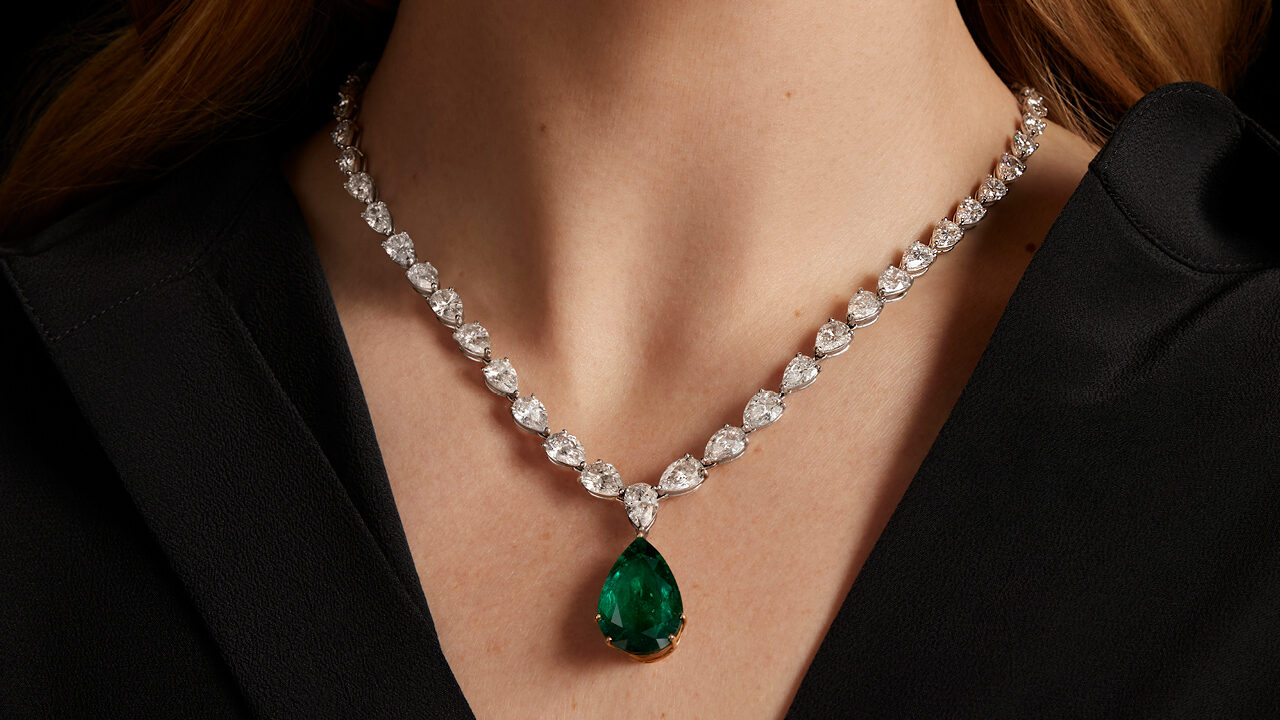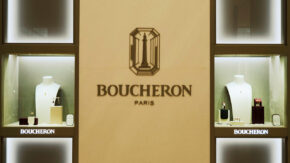Hammering out the details: Signed jewels and white diamonds are some of the safer bets for collectors, insiders say.
For the past 15 years, momentous events — including wars, recessions and Covid-19 — have had little impact on the auction market for gems and jewels. During the worst and best of times, the monied class has viewed hard luxuries like jewels and watches as sound investments and collectible items of beauty. In addition, auction houses have proven agile in developing creative and innovative ways to sell their items. Some auction-house officials say they’ve also been successful in attracting a new generation of collectors through online sales and special selling exhibitions.
This resiliency was highly evident in the first half of the year as rare items reached record-breaking prices. However, with the ongoing Russian invasion of Ukraine and sky-high inflation, prices for marquee items leveled off in the latter half of 2022, leading to what may be a cautious 2023.
Expert appraisals
“It’s going to be interesting what this year brings in the auction world,” says Benjamin Goldberg of New York-based diamond and high-jewelry firm William Goldberg.
Quig Bruning, head of jewelry for Sotheby’s Americas, says it is more difficult to predict what will happen this year than in the past. “Usually, at this point in time, we have a pretty good sense of what the market looks like for the next six to 12 months,” he explains. “This year, we’re all trying to figure out what’s going on in the world. It will have an impact.”
Buyers are getting younger, a trend that should continue into the new year amid the draw of online sales and themed selling events, Bruning adds. “We had an aging demographic getting older year over year, and now it is creeping down a little, as we are attracting more younger buyers than we ever have before and becoming a much bigger player in all categories.”
In that vein, he also reports “seeing a push from buyers in the Middle East.”
Collectors continue to value high-quality items, and this, too, will likely persist, according to Greg Kwiat, CEO of Fred Leighton and owner of Kwiat Diamonds. “I think the auction houses had a mixed year, but they still showed a lot of strength in certain categories. There were ups and downs in prices achieved, and there were [auction] lots not sold. If I’m trying to understand what it all means, it’s that there is still a very active customer base in the gems and jewelry market. Great pieces still attract those who seek value. That’s the story of the market today.”
Vigorous bidding
The leveling-off in the latter part of the year did little to dampen year-end totals for the auction houses. At Sotheby’s, global jewelry sales came to $507.2 million for 2022, up by “more than two-thirds” from 2021, a spokesperson said.
Christie’s combined its jewelry sales with its luxury category, which includes watches, handbags and wine. This group saw sales reach $988 million for the year, a 2% increase.
At Bonhams, 2022 global jewelry sales increased by 23% year on year to $73.98 million, according to global head of jewelry Jean Ghika. “This makes 2022 the most successful year for the Bonhams global jewelry department to date.”
Much of this increase is attributable to the proliferation of online and themed sales at auction houses, as these add to the number of items on offer each year. Some dealers have expressed concern that the growing number of products moving through auction houses is holding down the value of individual items, even as sales totals increase.
“There’s a lot of auction houses, and they all are competing for the same wallets,” Kwiat says. “The pace at which things are becoming available is increasing. With this pace, there is a decrease in the urgency of buyers to purchase, because it’s as if there’s always going to be something new on the horizon.”
This may have been the reason for the disappointing results of the De Beers Exceptional Blue Collection, posits gemologist Gary Roskin of the online magazine Roskin Gem News Report. Sotheby’s has been offering the group of eight fancy-blue diamonds over several auctions.
“Climbing out on a limb, I think that the rarity factor became overshadowed by the group image. Those of us in the colored-gemstone arena call that the Tucson effect,” Roskin says. “Because you see so many in a group, as you would see Paraiba tourmalines at the Tucson gem and mineral shows, they must not be as rare as we have been led to believe. And nothing is further from the truth.”
Sotheby’s in particular had an extremely active year, creating more online sales and special selling exhibitions, such as “Brilliant & Black” in London, which featured Black jewelry artists and designers; “Art as Jewelry as Art” in New York, focusing on pieces by some of the most innovative and recognized fine artists of the 20th and 21st centuries; and “Egyptomania,” specializing in historic Egyptian revival jewelry.
Auction houses are doing a good job of diversifying and segmenting their offerings, Bruning believes. “If you look at the auctions we’re conducting, we had a 560-lot auction that was two-and-a-half months before the December [Magnificent Jewels] sale of 160 lots. Maybe there are more auctions [these days], but they are much more tightly curated so you can offer things that are special.”
The auction houses are also doing a good job of avoiding duplicate items at these events, he continues. “We’re curating sales that have meaning and make sense in a way that benefits our clients while also benefiting the market.”
More than a passing fancy
The best barometer by which to judge the highs and lows of 2022 is fancy-colored diamonds. The first half experienced sales approaching or surpassing all-time records, while the second half saw prices cool off, and in a few cases, highly touted gems failed to sell (see analysis here).
David Doppelt’s firm, Jonathan Doppelt, specializes in fancy-yellow diamonds. One sale at the end of the year gave him hope that collectors were back to favoring these stones. The Golden Canary — a 303.10-carat, fancy-deep-brownish-yellow diamond — sold for $12.4 million at Sotheby’s New York on December 7. It was below estimates but was still the third-most valuable yellow diamond ever to sell at auction.
“Yellow diamonds are having a mini renaissance after a soft few years,” he states.
Consistency in colorless
As with fancy-colored diamonds, the larger white-diamond sales came early in the year, while things leveled off toward the end of 2022. However, prices grew on a consistent basis overall, which provides confidence for both buyers and sellers. This confidence is likely to keep up, particularly with the volatility in the crypto world, forecasts Goldberg.
“White diamonds were very stable during the first half of last year,” he says. “I think that now there’s a bit of a softening, but not crazy fluctuations. Even with the bids softening, there are still amazing stones to buy.”
That said, he continues, “they’re not growing on trees. We are not seeing a ton of goods in the market…. There’s lots of competition.”
Among the high points for the year were The Rock, a pear-shaped, 228.31-carat diamond with G color and VS1 clarity that fetched nearly $22 million at the Christie’s Geneva sale in May; the Light of Africa, an emerald-cut, 103.49-carat, D-flawless stone that netted more than $20 million at Christie’s New York in June; and the pear-shaped, 101.41-carat, D, internally flawless Juno diamond, which sold for $12.9 million at Sotheby’s New York in June.
Unlike some others, Goldberg believes the auction season ended on a strong note. “It was very impressive what the auctions achieved at the end of the year,” he says. “The first six months were amazing. Things had to cool down a little bit.”
Quality sells
Roskin says a combination of economic challenges and a lack of supply due to the global pandemic made it difficult for auction houses to keep up with the demand for the highest-quality gems during 2022.
“If they made it to market, they sold well. Last year, we saw a number of exceptional blue sapphires outperforming their auction estimates. Rubies and emeralds did not see this same growth, but I feel this was in part due to the few important pieces coming to auction,” he comments.
Generally speaking, last year saw solid results for “great colored gemstones like Paraiba tourmalines, padparadscha sapphires, demantoid garnets, spinels, alexandrites, even mineral specimens and objets d’art,” he adds. “Not surprisingly, exceptional color sold with very positive results, while the reasonably nice-color pieces were left disappointed.”
He predicts “even more discrimination in 2023. The exceptional, important pieces will be doing extremely well, with the respectable gems not getting as much respect as maybe they should.”
Among the highlights Roskin cites from recent auctions were a cushion-cut, 16.46-carat sapphire that fetched $2.1 million; a 38.51-carat Ceylon sapphire that sold for $516,600; and a sugarloaf cabochon-cut, 7.37-carat Kashmir sapphire that realized $604,800. They all sold at Sotheby’s New York in December. A large Ceylon sapphire cabochon sold for $1.3 million at Christie’s New York the same month.
Ghika of Bonhams singles out a diamond necklace with 25 cushion-shaped rubies that sold for more than $1.2 million at its November Hong Kong sale.
Vital signs
Colored gems in signed jewels from historic houses such as Tiffany & Co., Van Cleef & Arpels, and Graff performed nicely, Roskin reports. This is consistent with historical auction trends and is another aspect of the market that will likely continue through 2023.
Ghika points to a couple of notable sales in this category at Bonhams, including a Cartier diamond bracelet from circa 1926 with seven rectangular and octagonal step-cut emeralds totaling approximately 101 carats. The piece fetched more than $3.2 million at the auction house’s New York sale in May. A Graff diamond necklace with a detachable pear-shaped, 13.88-carat Colombian emerald drop sold at the September Bonhams sale in London for $570,207, she adds.
You can’t underestimate the importance of signed jewels, particularly from the historical French houses, Bruning stresses. “Jewels by well-known makers are being sought after by an unbelievable breadth and depth of clientele,” he says.
He observes two notable developments in this area. “First, there’s a push for other makers, with big prices achieved for jewels from brands like Bulgari, Tiffany and Raymond Yard. People are beginning to see them as equally beautiful, rare and exceptional.” At the same time, he says, “there’s this desire and craving in the market for contemporary jewels and designers, such as JAR and Hemmerle.”
Kwiat agrees that the collectability of signed jewels and important period pieces remains as strong as ever. In fact, he believes these pieces might become even more desirable in what may be a period of instability — and that collectors might be willing to pay even steeper prices for jewels from high-jewelry houses that have proven investment potential.
“Great period pieces and antique pieces are still exciting to certain collectors because of the beauty of the design, the important stones, and the quality of craftsmanship,” he says. “Items with royal and noble provenance tend to drive a lot of excitement as well.”
While many collectors are focusing on signed jewels, there’s a great deal of value in unsigned period pieces of high craftsmanship and important materials, according to Bruning. “With this focus on jewels by well-known manufacturers, you can have a beautiful Art Deco bracelet for far less.
We view it as an opportunity on the purchasing side.”
Bruning also notes the timeless appeal of historic jewels. The house’s “Egyptomania” sale “was a great success, with the Medusa pendant by Louis Comfort Tiffany selling for more than $3 million,” he reports. “It reinforces the notion that auctions are great with rare, important and historic items.”
Another notable change in recent years, says Kwiat, is that some dealers are mimicking retail collectors by becoming long-term holders of pieces, which may be even more significant during unpredictable times.
“When you hold something beautiful, you don’t have to worry,” he says. “It’s not fruit. It doesn’t go bad.”
Image: Graff diamond necklace with detachable pear-shaped, 13.88-carat Colombian emerald drop, which sold at Bonhams in September for $570,207. (Bonhams)



